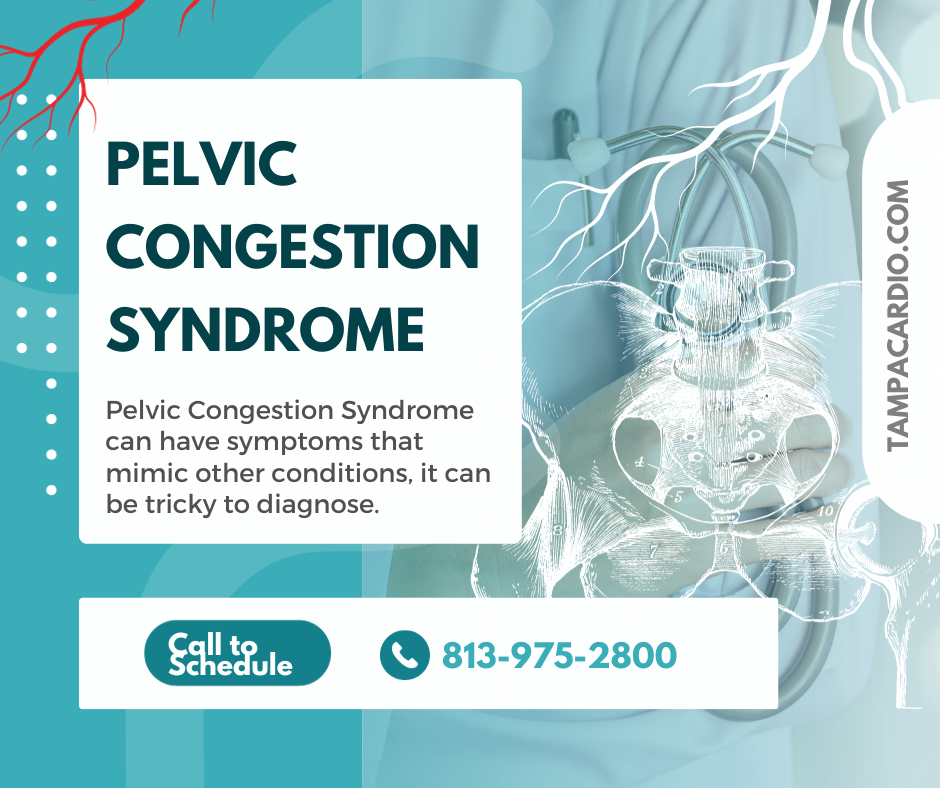Pelvic Congestion Syndrome: A Comprehensive Guide to Understanding and Overcoming It
Posted by: Tampa Cardio
On: December 22, 2023

Pelvic pain can be a life-altering experience, especially for women who experience it. Many women are aware of some of the common conditions that can cause pelvic pain, such as fibroids, endometriosis, and pelvic inflammatory disease. However, there is one condition that is often overlooked and can have a significant impact on a woman’s quality of life: Pelvic Congestion Syndrome.
In this article, we will explore what Pelvic Congestion Syndrome is, what causes it, the symptoms to look out for, and what you can do to manage it.
What is Pelvic Congestion Syndrome?
Pelvic Congestion Syndrome is a condition that affects women and is characterized by chronic pelvic pain. It occurs when there’s increased blood flow in the pelvic veins and damage to the valves inside the veins. This causes blood to pool in the veins, which can cause pain, heaviness, and discomfort. Many women that have PCS experience worsening symptoms with standing or sitting for long periods, during and after sex and exercise.
What are the symptoms of Pelvic Congestion Syndrome?
The symptoms of Pelvic Congestion Syndrome can vary greatly and can be challenging to identify. Often, women with PCS experience constant pain in the pelvic region, lower back, and hips. Other common symptoms are discomfort during sexual activity, increased pain during menstruation, and urinary incontinence. In some cases, women may experience swelling and visible varicose veins in the vulva region. These symptoms often impact daily activities and can lead to depression and anxiety in some instances.
How is Pelvic Congestion Syndrome diagnosed?
Since Pelvic Congestion Syndrome can have symptoms that mimic other conditions, it can be tricky to diagnose. However, ultrasound and MRIs can detect enlarged veins and obstruction in the veins. Often, a doctor will need to perform an angiogram to confirm the source of the overwhelm beading into pelvic veins and then target them. It remains an uncommonly diagnosed condition compared to anyone with complaints of pelvic pain and typically seeks medical advice on specific causes.
What can you do to manage Pelvic Congestion Syndrome?
There are several avenues a woman diagnosed with PCS can explore. Since pelvic congestion syndrome is a vascular condition, medications like anti-inflammatory, painkillers, hormonal methods, and pelvic exercises, may help to diminish pain and have some impact on PCS. Surgical treatment and inserting a stent or blocking abnormal veins with a special medical glue can also reduce blood flow to the trouble areas. The primary care physician, gynecologist, or specialized interventional radiologist should prescribe the necessary treatment for pelvic congestion syndrome based on the severity of the case.
Pelvic Congestion Syndrome is an uncommon yet painful condition that affects many women. Since it is often misdiagnosed, we hope this blog post has been insightful in identifying what it is, and common symptoms, and exploring what you can do to manage it. Be sure to speak to a medical professional if you’re experiencing prolonged pelvic pain and take steps to care for your well-being while maintaining good pelvic hygiene. Although pelvic congestion syndrome is not curable at present, with the right treatment, you can manage and significantly improve the symptoms.
At Tampa Cardiovascular Associates we specialize in PCS. If suspect you may have PCS and are experiencing symptoms, please give us a call at 813-975-2800 to schedule your consultation. www.Tampacardio.com.
Posted by: Tampa Cardio
On: 22/12/2023
